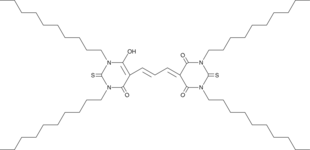Chemicals
Showing 17551–17700 of 41137 results
-
Dipeptide diaminobutyroyl benzylamide is a biomimetic peptide and a muscarinic acetylcholine receptor antagonist.{45360} It mimics the action of the temple viper (T. wagleri) venom peptide Waglerin-1 to block sodium uptake and induce muscle relaxation.
Brand:CaymanSKU:27566 - 100 mgAvailable on backorder
Dipeptide diaminobutyroyl benzylamide is a biomimetic peptide and a muscarinic acetylcholine receptor antagonist.{45360} It mimics the action of the temple viper (T. wagleri) venom peptide Waglerin-1 to block sodium uptake and induce muscle relaxation.
Brand:CaymanSKU:27566 - 250 mgAvailable on backorder
Dipeptide diaminobutyroyl benzylamide is a biomimetic peptide and a muscarinic acetylcholine receptor antagonist.{45360} It mimics the action of the temple viper (T. wagleri) venom peptide Waglerin-1 to block sodium uptake and induce muscle relaxation.
Brand:CaymanSKU:27566 - 500 mgAvailable on backorder
Diphemanil is a quaternary ammonium anticholinergic agent.{53536} It induces relaxation of isolated guinea pig trachea strips precontracted with methacholine (EC50 = 0.12 nM). Diphemanil reverses increases in lung resistance and decreases in dynamic lung compliance induced by the non-selective acetylcholine receptor agonist carbachol (carbamoylcholine; Item No. 14486) in vagotomized cats (ED50s = 17.5 and 19.3 µg/kg, respectively). It reduces salivation induced by the muscarinic acetylcholine receptor agonist pilocarpine in mice when administered subcutaneously at doses ranging from 1.25 to 10 mg/kg.{53537}
Brand:CaymanSKU:30090 - 100 mgAvailable on backorder
Diphemanil is a quaternary ammonium anticholinergic agent.{53536} It induces relaxation of isolated guinea pig trachea strips precontracted with methacholine (EC50 = 0.12 nM). Diphemanil reverses increases in lung resistance and decreases in dynamic lung compliance induced by the non-selective acetylcholine receptor agonist carbachol (carbamoylcholine; Item No. 14486) in vagotomized cats (ED50s = 17.5 and 19.3 µg/kg, respectively). It reduces salivation induced by the muscarinic acetylcholine receptor agonist pilocarpine in mice when administered subcutaneously at doses ranging from 1.25 to 10 mg/kg.{53537}
Brand:CaymanSKU:30090 - 25 mgAvailable on backorder
Diphemanil is a quaternary ammonium anticholinergic agent.{53536} It induces relaxation of isolated guinea pig trachea strips precontracted with methacholine (EC50 = 0.12 nM). Diphemanil reverses increases in lung resistance and decreases in dynamic lung compliance induced by the non-selective acetylcholine receptor agonist carbachol (carbamoylcholine; Item No. 14486) in vagotomized cats (ED50s = 17.5 and 19.3 µg/kg, respectively). It reduces salivation induced by the muscarinic acetylcholine receptor agonist pilocarpine in mice when administered subcutaneously at doses ranging from 1.25 to 10 mg/kg.{53537}
Brand:CaymanSKU:30090 - 250 mgAvailable on backorder
Diphemanil is a quaternary ammonium anticholinergic agent.{53536} It induces relaxation of isolated guinea pig trachea strips precontracted with methacholine (EC50 = 0.12 nM). Diphemanil reverses increases in lung resistance and decreases in dynamic lung compliance induced by the non-selective acetylcholine receptor agonist carbachol (carbamoylcholine; Item No. 14486) in vagotomized cats (ED50s = 17.5 and 19.3 µg/kg, respectively). It reduces salivation induced by the muscarinic acetylcholine receptor agonist pilocarpine in mice when administered subcutaneously at doses ranging from 1.25 to 10 mg/kg.{53537}
Brand:CaymanSKU:30090 - 50 mgAvailable on backorder
Diphencyprone (DCP) is a contact sensitizing agent.{42859,42860,42861} Pretreatment with DCP reduces symptom severity in a mouse model of experimental autoimmune encephalomyelitis (EAE) induced by myelin basic protein (1-10) (MBP1-10).{42859} It enhances IL-10 production and antigen-specific IgG2a antibody responses and reduces anaphylaxis and asthma induced by ovalbumin in mice when administered during ovalbumin immunization at a concentration of 1% v/v.{42860} Topical administration of DCP increases intrafollicular CD4+ and CD8+ T cells, reduces upper dermal inflammation, and stimulates hair growth in the C3H/HeJ mouse model of alopecia areta.{42861} Formulations containing DCP have been used in the treatment of alopecia areta.
Brand:CaymanSKU:27982 - 1 gAvailable on backorder
Diphencyprone (DCP) is a contact sensitizing agent.{42859,42860,42861} Pretreatment with DCP reduces symptom severity in a mouse model of experimental autoimmune encephalomyelitis (EAE) induced by myelin basic protein (1-10) (MBP1-10).{42859} It enhances IL-10 production and antigen-specific IgG2a antibody responses and reduces anaphylaxis and asthma induced by ovalbumin in mice when administered during ovalbumin immunization at a concentration of 1% v/v.{42860} Topical administration of DCP increases intrafollicular CD4+ and CD8+ T cells, reduces upper dermal inflammation, and stimulates hair growth in the C3H/HeJ mouse model of alopecia areta.{42861} Formulations containing DCP have been used in the treatment of alopecia areta.
Brand:CaymanSKU:27982 - 10 gAvailable on backorder
Diphencyprone (DCP) is a contact sensitizing agent.{42859,42860,42861} Pretreatment with DCP reduces symptom severity in a mouse model of experimental autoimmune encephalomyelitis (EAE) induced by myelin basic protein (1-10) (MBP1-10).{42859} It enhances IL-10 production and antigen-specific IgG2a antibody responses and reduces anaphylaxis and asthma induced by ovalbumin in mice when administered during ovalbumin immunization at a concentration of 1% v/v.{42860} Topical administration of DCP increases intrafollicular CD4+ and CD8+ T cells, reduces upper dermal inflammation, and stimulates hair growth in the C3H/HeJ mouse model of alopecia areta.{42861} Formulations containing DCP have been used in the treatment of alopecia areta.
Brand:CaymanSKU:27982 - 5 gAvailable on backorder
Diphencyprone (DCP) is a contact sensitizing agent.{42859,42860,42861} Pretreatment with DCP reduces symptom severity in a mouse model of experimental autoimmune encephalomyelitis (EAE) induced by myelin basic protein (1-10) (MBP1-10).{42859} It enhances IL-10 production and antigen-specific IgG2a antibody responses and reduces anaphylaxis and asthma induced by ovalbumin in mice when administered during ovalbumin immunization at a concentration of 1% v/v.{42860} Topical administration of DCP increases intrafollicular CD4+ and CD8+ T cells, reduces upper dermal inflammation, and stimulates hair growth in the C3H/HeJ mouse model of alopecia areta.{42861} Formulations containing DCP have been used in the treatment of alopecia areta.
Brand:CaymanSKU:27982 - 500 mgAvailable on backorder
Diphenhydramine (hydrochloride) (Item No. 22489) is an analytical reference standard that is categorized as an antihistamine.{15199} It increases hallucinations and manic behavior associated with use of products marketed as bath salts.{36168} This product is intended for analytical forensic applications. This product is also available as a general research tool (Item No. 11158).
Brand:CaymanSKU:22489 -Out of stock
Diphenhydramine (DPH) is a first generation antihistamine that is a potent antagonist of the histamine H1 receptor (Ki = 11.7 nM using human recombinant receptors).{15199,22787} DPH readily crosses the blood-brain barrier and produces diverse cognitive and psychomotor effects.{15199,22788} DPH also antagonizes muscarinic cholinergic receptors (Kis = 100 to 260 nM for M1-M5), increasing the range of central nervous system effects and applications.{22786} This product is also available as an analytical reference standard (Item No. 22489).
Brand:CaymanSKU:11158 - 100 mgAvailable on backorder
Diphenhydramine (DPH) is a first generation antihistamine that is a potent antagonist of the histamine H1 receptor (Ki = 11.7 nM using human recombinant receptors).{15199,22787} DPH readily crosses the blood-brain barrier and produces diverse cognitive and psychomotor effects.{15199,22788} DPH also antagonizes muscarinic cholinergic receptors (Kis = 100 to 260 nM for M1-M5), increasing the range of central nervous system effects and applications.{22786} This product is also available as an analytical reference standard (Item No. 22489).
Brand:CaymanSKU:11158 - 250 mgAvailable on backorder
Diphenhydramine (hydrochloride) (Item No. 22489) is an analytical reference standard that is categorized as an antihistamine.{15199} It increases hallucinations and manic behavior associated with use of products marketed as bath salts.{36168} This product is intended for analytical forensic applications. This product is also available as a general research tool (Item No. 11158).
Brand:CaymanSKU:22489 -Out of stock
Diphenidine is a homeomorph of the NMDA receptor channel blocker, MK 801, that has been identified as a designer drug.{26258} The (S)- and (R)- enantiomers of diphenidine have been reported to inhibit MK 801 binding to NMDA receptors in rat brain membranes with Ki values of 0.13 and 5.25 µM, respectively.{26258} It has been studied as a neuroprotective agent for the treatment of brain injury following hypoxia.{26257} This product is intended for forensic and research applications.
Brand:CaymanSKU:-Diphenidine is a homeomorph of the NMDA receptor channel blocker, MK 801, that has been identified as a designer drug.{26258} The (S)- and (R)- enantiomers of diphenidine have been reported to inhibit MK 801 binding to NMDA receptors in rat brain membranes with Ki values of 0.13 and 5.25 µM, respectively.{26258} It has been studied as a neuroprotective agent for the treatment of brain injury following hypoxia.{26257} This product is intended for forensic and research applications.
Brand:CaymanSKU:-Diphenidine is a homeomorph of the NMDA receptor channel blocker, MK 801, that has been identified as a designer drug.{26258} The (S)- and (R)- enantiomers of diphenidine have been reported to inhibit MK 801 binding to NMDA receptors in rat brain membranes with Ki values of 0.13 and 5.25 µM, respectively.{26258} It has been studied as a neuroprotective agent for the treatment of brain injury following hypoxia.{26257} This product is intended for forensic and research applications.
Brand:CaymanSKU:-Diphenidol is a non-selective muscarinic acetylcholine receptor antagonist.{30252} It is also a non-specific inhibitor of voltage-gated ion channels (Na+, K+, and Ca2+) in neurons.{30250} Diphenidol has been used to inhibit rotation-induced firing of type 1 medial vestibular nucleus neurons in a cat model of vertigo and to block the chemoreceptor trigger zone in the medulla that controls apomorphine-induced vomiting in a dog model of emesis.{30249,30251}
Brand:CaymanSKU:-Available on backorder
Diphenidol is a non-selective muscarinic acetylcholine receptor antagonist.{30252} It is also a non-specific inhibitor of voltage-gated ion channels (Na+, K+, and Ca2+) in neurons.{30250} Diphenidol has been used to inhibit rotation-induced firing of type 1 medial vestibular nucleus neurons in a cat model of vertigo and to block the chemoreceptor trigger zone in the medulla that controls apomorphine-induced vomiting in a dog model of emesis.{30249,30251}
Brand:CaymanSKU:-Available on backorder
Diphenidol is a non-selective muscarinic acetylcholine receptor antagonist.{30252} It is also a non-specific inhibitor of voltage-gated ion channels (Na+, K+, and Ca2+) in neurons.{30250} Diphenidol has been used to inhibit rotation-induced firing of type 1 medial vestibular nucleus neurons in a cat model of vertigo and to block the chemoreceptor trigger zone in the medulla that controls apomorphine-induced vomiting in a dog model of emesis.{30249,30251}
Brand:CaymanSKU:-Available on backorder
Diphenidol is a non-selective muscarinic acetylcholine receptor antagonist.{30252} It is also a non-specific inhibitor of voltage-gated ion channels (Na+, K+, and Ca2+) in neurons.{30250} Diphenidol has been used to inhibit rotation-induced firing of type 1 medial vestibular nucleus neurons in a cat model of vertigo and to block the chemoreceptor trigger zone in the medulla that controls apomorphine-induced vomiting in a dog model of emesis.{30249,30251}
Brand:CaymanSKU:-Available on backorder
Diphenylamine is an antioxidant that has been found in a variety of plants, including black and green tea plants, onion, and citrus.{37757,37758} It inhibits the oxidation of α-farnesene in solution as well as in the coating of Granny Smith apples.{37757} Diphenylamine (1,000 ppm) prevents superficial scald in several varieties of apples when applied by dipping or wrapping post-harvest.{37759} It induces toxicity in the aquatic organisms D. magna, P. phosphoreum, and V. fischeri (EC50s = 2.3, ~4.75, and ~5.5 mg/L, respectively).{37758} Diphenylamine has been used in colorimetric assays for the quantification of DNA.{37760} Formulations containing diphenylamine have been used to prevent deterioration of apple and pear crops post-harvest.
Brand:CaymanSKU:24250 - 5 gAvailable on backorder
Diphenyleneiodonium (DPI) is an irreversible inhibitor of iNOS and eNOS with IC50 values of 50 nM and 0.3 µM, respectively.{952} This inhibition is potent, irreversible, and time and temperature dependent.{952} NADPH, NADP+, and 2’5′-ADP blocks the inhibitory action of DPI. Similarly, FAD or FMN protect NOS from inhibition by DPI.{952}
Brand:CaymanSKU:81050 - 10 mgAvailable on backorder
Diphenyleneiodonium (DPI) is an irreversible inhibitor of iNOS and eNOS with IC50 values of 50 nM and 0.3 µM, respectively.{952} This inhibition is potent, irreversible, and time and temperature dependent.{952} NADPH, NADP+, and 2’5′-ADP blocks the inhibitory action of DPI. Similarly, FAD or FMN protect NOS from inhibition by DPI.{952}
Brand:CaymanSKU:81050 - 5 mgAvailable on backorder
The Wittig reaction is a frequently used method for olefin synthesis involving a phosphorane ylide and an aldehyde or ketone. DPP is a common by-product of this reaction. DPP can be used as a standard in analyzing products of synthetic routes that utilize the Wittig reaction.
Brand:CaymanSKU:10011337 - 10 mgAvailable on backorder
The Wittig reaction is a frequently used method for olefin synthesis involving a phosphorane ylide and an aldehyde or ketone. DPP is a common by-product of this reaction. DPP can be used as a standard in analyzing products of synthetic routes that utilize the Wittig reaction.
Brand:CaymanSKU:10011337 - 100 mgAvailable on backorder
The Wittig reaction is a frequently used method for olefin synthesis involving a phosphorane ylide and an aldehyde or ketone. DPP is a common by-product of this reaction. DPP can be used as a standard in analyzing products of synthetic routes that utilize the Wittig reaction.
Brand:CaymanSKU:10011337 - 5 mgAvailable on backorder
The Wittig reaction is a frequently used method for olefin synthesis involving a phosphorane ylide and an aldehyde or ketone. DPP is a common by-product of this reaction. DPP can be used as a standard in analyzing products of synthetic routes that utilize the Wittig reaction.
Brand:CaymanSKU:10011337 - 50 mgAvailable on backorder
Dipivefrin is a prodrug of epinephrine that is hydrolyzed by cholinesterase and other esterases in the cornea to epinephrine.{36428} It reduces the density of cultured bovine primary trabecular meshwork cells (IC50 = 115 µM).{36424} Additionally, it induces an elongated, fibroblast-like morphology and disrupts the actin cytoskeleton in bovine primary trabecular meshwork cells when used at a concentration of 103 µM.{36424} In cultured bovine corneal endothelial cells, dipivefrin (28 µM) enhances calcium signaling and induces cytotoxicity.{36426,36425} Dipivefrin also suppresses primary human corneal keratinocyte proliferation when used at a concentration of 280 µM.{36427} Formulations containing dipivefrin have been used alone and in combination with β-adrenergic receptor antagonists for the treatment of glaucoma.
Brand:CaymanSKU:24028 - 100 mgAvailable on backorder
Dipivefrin is a prodrug of epinephrine that is hydrolyzed by cholinesterase and other esterases in the cornea to epinephrine.{36428} It reduces the density of cultured bovine primary trabecular meshwork cells (IC50 = 115 µM).{36424} Additionally, it induces an elongated, fibroblast-like morphology and disrupts the actin cytoskeleton in bovine primary trabecular meshwork cells when used at a concentration of 103 µM.{36424} In cultured bovine corneal endothelial cells, dipivefrin (28 µM) enhances calcium signaling and induces cytotoxicity.{36426,36425} Dipivefrin also suppresses primary human corneal keratinocyte proliferation when used at a concentration of 280 µM.{36427} Formulations containing dipivefrin have been used alone and in combination with β-adrenergic receptor antagonists for the treatment of glaucoma.
Brand:CaymanSKU:24028 - 25 mgAvailable on backorder
Dipivefrin is a prodrug of epinephrine that is hydrolyzed by cholinesterase and other esterases in the cornea to epinephrine.{36428} It reduces the density of cultured bovine primary trabecular meshwork cells (IC50 = 115 µM).{36424} Additionally, it induces an elongated, fibroblast-like morphology and disrupts the actin cytoskeleton in bovine primary trabecular meshwork cells when used at a concentration of 103 µM.{36424} In cultured bovine corneal endothelial cells, dipivefrin (28 µM) enhances calcium signaling and induces cytotoxicity.{36426,36425} Dipivefrin also suppresses primary human corneal keratinocyte proliferation when used at a concentration of 280 µM.{36427} Formulations containing dipivefrin have been used alone and in combination with β-adrenergic receptor antagonists for the treatment of glaucoma.
Brand:CaymanSKU:24028 - 50 mgAvailable on backorder
Diproqualone (Item No. 21836) is an analytical reference standard. This product is intended for research and forensic applications.
Brand:CaymanSKU:21836 -Out of stock
Diproqualone (Item No. 21836) is an analytical reference standard. This product is intended for research and forensic applications.
Brand:CaymanSKU:21836 -Out of stock
Diprotin A is a tripeptide inhibitor of dipeptidyl peptidase 4 (DPP-4; IC50 = 1.1 μg/ml).{42893} It inhibits degradation of glucagon-like peptide 1 (GLP-1; Item No. 24460) in culture with insulin-secreting BRIN-BD11 rat pancreatic β-cells when used at a concentration of 25 μM.{42894} Diprotin A (5 mg/ml) pre-incubation enhances chemotaxis of murine embryonic stem cells towards stromal cell-derived factor-1 (SDF-1/CXCL12) in vitro.{42895} Pre-incubation of CD34+ human umbilical cord blood cells with diprotin A (5 mM) prior to injection increases engraftment in NOD/SCID recipient mice.{42896}
Brand:CaymanSKU:28014 - 10 mgAvailable on backorder
Diprotin A is a tripeptide inhibitor of dipeptidyl peptidase 4 (DPP-4; IC50 = 1.1 μg/ml).{42893} It inhibits degradation of glucagon-like peptide 1 (GLP-1; Item No. 24460) in culture with insulin-secreting BRIN-BD11 rat pancreatic β-cells when used at a concentration of 25 μM.{42894} Diprotin A (5 mg/ml) pre-incubation enhances chemotaxis of murine embryonic stem cells towards stromal cell-derived factor-1 (SDF-1/CXCL12) in vitro.{42895} Pre-incubation of CD34+ human umbilical cord blood cells with diprotin A (5 mM) prior to injection increases engraftment in NOD/SCID recipient mice.{42896}
Brand:CaymanSKU:28014 - 100 mgAvailable on backorder
Diprotin A is a tripeptide inhibitor of dipeptidyl peptidase 4 (DPP-4; IC50 = 1.1 μg/ml).{42893} It inhibits degradation of glucagon-like peptide 1 (GLP-1; Item No. 24460) in culture with insulin-secreting BRIN-BD11 rat pancreatic β-cells when used at a concentration of 25 μM.{42894} Diprotin A (5 mg/ml) pre-incubation enhances chemotaxis of murine embryonic stem cells towards stromal cell-derived factor-1 (SDF-1/CXCL12) in vitro.{42895} Pre-incubation of CD34+ human umbilical cord blood cells with diprotin A (5 mM) prior to injection increases engraftment in NOD/SCID recipient mice.{42896}
Brand:CaymanSKU:28014 - 25 mgAvailable on backorder
Diprotin A is a tripeptide inhibitor of dipeptidyl peptidase 4 (DPP-4; IC50 = 1.1 μg/ml).{42893} It inhibits degradation of glucagon-like peptide 1 (GLP-1; Item No. 24460) in culture with insulin-secreting BRIN-BD11 rat pancreatic β-cells when used at a concentration of 25 μM.{42894} Diprotin A (5 mg/ml) pre-incubation enhances chemotaxis of murine embryonic stem cells towards stromal cell-derived factor-1 (SDF-1/CXCL12) in vitro.{42895} Pre-incubation of CD34+ human umbilical cord blood cells with diprotin A (5 mM) prior to injection increases engraftment in NOD/SCID recipient mice.{42896}
Brand:CaymanSKU:28014 - 50 mgAvailable on backorder
5-Methoxy-N,N-diisopropyltryptamine (5-MeO DiPT) (Item No. 11865) is a psychedelic hallucinogen which is abused worldwide. Known informally as ‘foxy’, this compound potently inhibits the re-uptake of dopamine, serotonin, and norepinephrine (IC50s = 65, 2.2, and 8.2 μM, respectively).{19758} DiPT is an uncommonly abused psychedelic drug related to 5-MeO DiPT. Its physiological and toxicological properties have not been extensively reported. This product is intended for forensic and research applications.
Brand:CaymanSKU:11550 - 10 mgAvailable on backorder
5-Methoxy-N,N-diisopropyltryptamine (5-MeO DiPT) (Item No. 11865) is a psychedelic hallucinogen which is abused worldwide. Known informally as ‘foxy’, this compound potently inhibits the re-uptake of dopamine, serotonin, and norepinephrine (IC50s = 65, 2.2, and 8.2 μM, respectively).{19758} DiPT is an uncommonly abused psychedelic drug related to 5-MeO DiPT. Its physiological and toxicological properties have not been extensively reported. This product is intended for forensic and research applications.
Brand:CaymanSKU:11550 - 25 mgAvailable on backorder
5-Methoxy-N,N-diisopropyltryptamine (5-MeO DiPT) (Item No. 11865) is a psychedelic hallucinogen which is abused worldwide. Known informally as ‘foxy’, this compound potently inhibits the re-uptake of dopamine, serotonin, and norepinephrine (IC50s = 65, 2.2, and 8.2 μM, respectively).{19758} DiPT is an uncommonly abused psychedelic drug related to 5-MeO DiPT. Its physiological and toxicological properties have not been extensively reported. This product is intended for forensic and research applications.
Brand:CaymanSKU:11550 - 5 mgAvailable on backorder
Dipyridamole is a phosphodiesterase 5A (PDE5A) inhibitor (IC50 = 574 nM) that prevents platelet aggregation by increasing cGMP levels and blocking the reuptake of adenosine via red blood cells.{23680,29326} It also scavenges the free radicals that inactivate cyclooxygenase, leading to the inhibition of platelet activation and thrombin generation.{23680} Dipyridamole has also been shown to inhibit PDE11A with an IC50 value of 370 nM and equilibrative nucleoside transporter 1 (ENT1) with a Ki value of 8.18 nM.{17520,29324} It inhibits replication of severe acute respiratory syndrome coronavirus 2 (SARS-CoV-2) in Vero E6 cells when used at a concentration of 100 nM.{49690} Formulations containing dipyridamole in combination with aspirin (Item No. 70260) have been used to prevent stroke and other cardiovascular events.{19319}
Brand:CaymanSKU:-Available on backorder
Dipyridamole is a phosphodiesterase 5A (PDE5A) inhibitor (IC50 = 574 nM) that prevents platelet aggregation by increasing cGMP levels and blocking the reuptake of adenosine via red blood cells.{23680,29326} It also scavenges the free radicals that inactivate cyclooxygenase, leading to the inhibition of platelet activation and thrombin generation.{23680} Dipyridamole has also been shown to inhibit PDE11A with an IC50 value of 370 nM and equilibrative nucleoside transporter 1 (ENT1) with a Ki value of 8.18 nM.{17520,29324} It inhibits replication of severe acute respiratory syndrome coronavirus 2 (SARS-CoV-2) in Vero E6 cells when used at a concentration of 100 nM.{49690} Formulations containing dipyridamole in combination with aspirin (Item No. 70260) have been used to prevent stroke and other cardiovascular events.{19319}
Brand:CaymanSKU:-Available on backorder
Dipyridamole is a phosphodiesterase 5A (PDE5A) inhibitor (IC50 = 574 nM) that prevents platelet aggregation by increasing cGMP levels and blocking the reuptake of adenosine via red blood cells.{23680,29326} It also scavenges the free radicals that inactivate cyclooxygenase, leading to the inhibition of platelet activation and thrombin generation.{23680} Dipyridamole has also been shown to inhibit PDE11A with an IC50 value of 370 nM and equilibrative nucleoside transporter 1 (ENT1) with a Ki value of 8.18 nM.{17520,29324} It inhibits replication of severe acute respiratory syndrome coronavirus 2 (SARS-CoV-2) in Vero E6 cells when used at a concentration of 100 nM.{49690} Formulations containing dipyridamole in combination with aspirin (Item No. 70260) have been used to prevent stroke and other cardiovascular events.{19319}
Brand:CaymanSKU:-Available on backorder
Diquat is a bipyridylium herbicide that, as a stable radical, acts as an electron acceptor in the electron transport chain and is reoxidized by molecular oxygen, producing reactive oxygen species (ROS).{37559} Diquat administration has been used to induce oxidative stress in vitro and in animal models.{37560,37561,37562} It increases the production of ROS and decreases the mitochondrial membrane potential in mitochondria isolated from porcine intestine leading to mitophagy when administered at a dose of 100 mg/kg.{37560} Formulations containing diquat have been used in agriculture for crop desiccation and defoliation.
Brand:CaymanSKU:26251 - 10 mgAvailable on backorder
Diquat is a bipyridylium herbicide that, as a stable radical, acts as an electron acceptor in the electron transport chain and is reoxidized by molecular oxygen, producing reactive oxygen species (ROS).{37559} Diquat administration has been used to induce oxidative stress in vitro and in animal models.{37560,37561,37562} It increases the production of ROS and decreases the mitochondrial membrane potential in mitochondria isolated from porcine intestine leading to mitophagy when administered at a dose of 100 mg/kg.{37560} Formulations containing diquat have been used in agriculture for crop desiccation and defoliation.
Brand:CaymanSKU:26251 - 25 mgAvailable on backorder
Diquat is a bipyridylium herbicide that, as a stable radical, acts as an electron acceptor in the electron transport chain and is reoxidized by molecular oxygen, producing reactive oxygen species (ROS).{37559} Diquat administration has been used to induce oxidative stress in vitro and in animal models.{37560,37561,37562} It increases the production of ROS and decreases the mitochondrial membrane potential in mitochondria isolated from porcine intestine leading to mitophagy when administered at a dose of 100 mg/kg.{37560} Formulations containing diquat have been used in agriculture for crop desiccation and defoliation.
Brand:CaymanSKU:26251 - 5 mgAvailable on backorder
Dirithromycin is a macrolide antibiotic. It is a prodrug of erythromycylamine (Item No. 28098) that has outstanding activity against Campylobacter.{31455} Dirithromycin is a group 3 agent with respect to its interaction with the cytochrome P450 (CYP) isoform 3A4, as it interferes poorly with CYP3A4 in vitro and generally does not alter drug metabolism in vivo.{22760}
Brand:CaymanSKU:-Available on backorder
Dirithromycin is a macrolide antibiotic. It is a prodrug of erythromycylamine (Item No. 28098) that has outstanding activity against Campylobacter.{31455} Dirithromycin is a group 3 agent with respect to its interaction with the cytochrome P450 (CYP) isoform 3A4, as it interferes poorly with CYP3A4 in vitro and generally does not alter drug metabolism in vivo.{22760}
Brand:CaymanSKU:-Available on backorder
Dirithromycin is a macrolide antibiotic. It is a prodrug of erythromycylamine (Item No. 28098) that has outstanding activity against Campylobacter.{31455} Dirithromycin is a group 3 agent with respect to its interaction with the cytochrome P450 (CYP) isoform 3A4, as it interferes poorly with CYP3A4 in vitro and generally does not alter drug metabolism in vivo.{22760}
Brand:CaymanSKU:-Available on backorder
Diroximel fumarate is a prodrug form of monomethyl fumarate (Item No. 27813).{53120} It undergoes esterase cleavage in the gut to release monomethyl fumarate. Formulations containing diroximel fumarate have been used in the treatment of relapsing-remitting multiple sclerosis.
Brand:CaymanSKU:29111 - 10 mgAvailable on backorder
Diroximel fumarate is a prodrug form of monomethyl fumarate (Item No. 27813).{53120} It undergoes esterase cleavage in the gut to release monomethyl fumarate. Formulations containing diroximel fumarate have been used in the treatment of relapsing-remitting multiple sclerosis.
Brand:CaymanSKU:29111 - 25 mgAvailable on backorder
Diroximel fumarate is a prodrug form of monomethyl fumarate (Item No. 27813).{53120} It undergoes esterase cleavage in the gut to release monomethyl fumarate. Formulations containing diroximel fumarate have been used in the treatment of relapsing-remitting multiple sclerosis.
Brand:CaymanSKU:29111 - 5 mgAvailable on backorder
Diroximel fumarate is a prodrug form of monomethyl fumarate (Item No. 27813).{53120} It undergoes esterase cleavage in the gut to release monomethyl fumarate. Formulations containing diroximel fumarate have been used in the treatment of relapsing-remitting multiple sclerosis.
Brand:CaymanSKU:29111 - 50 mgAvailable on backorder
DISBAC10 is a voltage-sensitive fluorescent probe used to study cell membrane electrical activity using FRET.{2601} DISBAC10 displays excitation/emission spectra of 540/560 nm, respectively. In a resting polarized cell, DISBAC10 resides on the outer leaflet of the membrane where it accepts photons from excited fluorescein-labeled proteins and re-emits the photons at a higher wavelength.{2601} Depolarization of the cell causes rapid translocation of DISBAC10 to the inner leaflet of the membrane, thereby increasing the distance between fluorophores and reducing the FRET signal. DISBAC10 can also be used in conjunction with fluorescein-labeled antibodies or receptor ligands to visualize specific cell classes.
Brand:CaymanSKU:200280 -Available on backorder
DISBAC10 is a voltage-sensitive fluorescent probe used to study cell membrane electrical activity using FRET.{2601} DISBAC10 displays excitation/emission spectra of 540/560 nm, respectively. In a resting polarized cell, DISBAC10 resides on the outer leaflet of the membrane where it accepts photons from excited fluorescein-labeled proteins and re-emits the photons at a higher wavelength.{2601} Depolarization of the cell causes rapid translocation of DISBAC10 to the inner leaflet of the membrane, thereby increasing the distance between fluorophores and reducing the FRET signal. DISBAC10 can also be used in conjunction with fluorescein-labeled antibodies or receptor ligands to visualize specific cell classes.
Brand:CaymanSKU:200280 -Available on backorder
DISBAC10 is a voltage-sensitive fluorescent probe used to study cell membrane electrical activity using FRET.{2601} DISBAC10 displays excitation/emission spectra of 540/560 nm, respectively. In a resting polarized cell, DISBAC10 resides on the outer leaflet of the membrane where it accepts photons from excited fluorescein-labeled proteins and re-emits the photons at a higher wavelength.{2601} Depolarization of the cell causes rapid translocation of DISBAC10 to the inner leaflet of the membrane, thereby increasing the distance between fluorophores and reducing the FRET signal. DISBAC10 can also be used in conjunction with fluorescein-labeled antibodies or receptor ligands to visualize specific cell classes.
Brand:CaymanSKU:200280 -Available on backorder
Brand:CaymanSKU:27005 - 100 mgAvailable on backorder
Brand:CaymanSKU:27005 - 25 mgAvailable on backorder
Brand:CaymanSKU:27005 - 50 mgAvailable on backorder
Disuccinimidyl glutarate (DSG) is a homobifunctional crosslinking agent that contains amine-reactive N-hydroxysuccinimide (NHS) ester groups at each end.{32478,32480} DSG is membrane-permeable and non-cleavable. DSG can be combined with formaldehyde fixation to improve the detection of specific protein-DNA complexes.{32479}
Brand:CaymanSKU:20646 -Available on backorder
Disuccinimidyl glutarate (DSG) is a homobifunctional crosslinking agent that contains amine-reactive N-hydroxysuccinimide (NHS) ester groups at each end.{32478,32480} DSG is membrane-permeable and non-cleavable. DSG can be combined with formaldehyde fixation to improve the detection of specific protein-DNA complexes.{32479}
Brand:CaymanSKU:20646 -Available on backorder
Disuccinimidyl glutarate (DSG) is a homobifunctional crosslinking agent that contains amine-reactive N-hydroxysuccinimide (NHS) ester groups at each end.{32478,32480} DSG is membrane-permeable and non-cleavable. DSG can be combined with formaldehyde fixation to improve the detection of specific protein-DNA complexes.{32479}
Brand:CaymanSKU:20646 -Available on backorder
Disuccinimidyl glutarate (DSG) is a homobifunctional crosslinking agent that contains amine-reactive N-hydroxysuccinimide (NHS) ester groups at each end.{32478,32480} DSG is membrane-permeable and non-cleavable. DSG can be combined with formaldehyde fixation to improve the detection of specific protein-DNA complexes.{32479}
Brand:CaymanSKU:20646 -Available on backorder
Disuccinimidyl suberate (DSS) is a bifunctional cross-linking reagent which contains two N-hydroxysuccinimide esters that are reactive toward primary amines. DSS is membrane-permeable and is commonly used to cross-link proteins in intact cells.{16862,16863}
Brand:CaymanSKU:13008 - 100 mgAvailable on backorder
Disuccinimidyl suberate (DSS) is a bifunctional cross-linking reagent which contains two N-hydroxysuccinimide esters that are reactive toward primary amines. DSS is membrane-permeable and is commonly used to cross-link proteins in intact cells.{16862,16863}
Brand:CaymanSKU:13008 - 250 mgAvailable on backorder
Disuccinimidyl suberate (DSS) is a bifunctional cross-linking reagent which contains two N-hydroxysuccinimide esters that are reactive toward primary amines. DSS is membrane-permeable and is commonly used to cross-link proteins in intact cells.{16862,16863}
Brand:CaymanSKU:13008 - 50 mgAvailable on backorder
Disuccinimidyl suberate (DSS) is a bifunctional cross-linking reagent which contains two N-hydroxysuccinimide esters that are reactive toward primary amines. DSS is membrane-permeable and is commonly used to cross-link proteins in intact cells.{16862,16863}
Brand:CaymanSKU:13008 - 500 mgAvailable on backorder
Disuccinimidyl sulfoxide (DSSO) is a protein cross-linking probe designed to be used with mass spectrometry (MS). It contains two symmetric collision-induced dissociation (CID)-cleavable sites that allow effective identification of DSSO-cross-linked peptides based on their distinct fragmentation patterns.{32323} The CID-induced separation of interlinked peptides in MS/MS permits MS3 analysis of single peptide chain fragment ions with defined modifications, due to DSSO remnants, for easy interpretation and unambiguous identification using existing database searching tools.{32323}
Brand:CaymanSKU:9002863 - 100 mgAvailable on backorder
Disuccinimidyl sulfoxide (DSSO) is a protein cross-linking probe designed to be used with mass spectrometry (MS). It contains two symmetric collision-induced dissociation (CID)-cleavable sites that allow effective identification of DSSO-cross-linked peptides based on their distinct fragmentation patterns.{32323} The CID-induced separation of interlinked peptides in MS/MS permits MS3 analysis of single peptide chain fragment ions with defined modifications, due to DSSO remnants, for easy interpretation and unambiguous identification using existing database searching tools.{32323}
Brand:CaymanSKU:9002863 - 250 mgAvailable on backorder
Disuccinimidyl sulfoxide (DSSO) is a protein cross-linking probe designed to be used with mass spectrometry (MS). It contains two symmetric collision-induced dissociation (CID)-cleavable sites that allow effective identification of DSSO-cross-linked peptides based on their distinct fragmentation patterns.{32323} The CID-induced separation of interlinked peptides in MS/MS permits MS3 analysis of single peptide chain fragment ions with defined modifications, due to DSSO remnants, for easy interpretation and unambiguous identification using existing database searching tools.{32323}
Brand:CaymanSKU:9002863 - 50 mgAvailable on backorder
Disuccinimidyl sulfoxide (DSSO) is a protein cross-linking probe designed to be used with mass spectrometry (MS). It contains two symmetric collision-induced dissociation (CID)-cleavable sites that allow effective identification of DSSO-cross-linked peptides based on their distinct fragmentation patterns.{32323} The CID-induced separation of interlinked peptides in MS/MS permits MS3 analysis of single peptide chain fragment ions with defined modifications, due to DSSO remnants, for easy interpretation and unambiguous identification using existing database searching tools.{32323}
Brand:CaymanSKU:9002863 - 500 mgAvailable on backorder
Disulfiram is a copper and zinc chelator and an irreversible inhibitor of aldehyde dehydrogenase (IC50 = 0.1 mM).{25186} It also inhibits the copper-dependent enzyme dopamine β-hydroxylase, which prevents the breakdown of dopamine and has been considered as a treatment for cocaine dependence.{25185} When in complex with copper, disulfiram has been shown to inhibit purified 20S proteasome (IC50 = 7.5 μM) and 26S proteasome (IC50 = 20 μM) from MDA-MB-0231 breast cancer cells.{25183,25182} Because disulfiram targets the ubiquitin-proteasome pathway, it has been investigated as an anti-cancer agent. Furthermore, at 250 nM it has been shown to induce reactive oxygen species, to activate JNK and p38 pathways, and to inhibit NF-κB activity, which suppresses self-renewal in cancer stem cells.{25187,25184}
Brand:CaymanSKU:-Disulfiram is a copper and zinc chelator and an irreversible inhibitor of aldehyde dehydrogenase (IC50 = 0.1 mM).{25186} It also inhibits the copper-dependent enzyme dopamine β-hydroxylase, which prevents the breakdown of dopamine and has been considered as a treatment for cocaine dependence.{25185} When in complex with copper, disulfiram has been shown to inhibit purified 20S proteasome (IC50 = 7.5 μM) and 26S proteasome (IC50 = 20 μM) from MDA-MB-0231 breast cancer cells.{25183,25182} Because disulfiram targets the ubiquitin-proteasome pathway, it has been investigated as an anti-cancer agent. Furthermore, at 250 nM it has been shown to induce reactive oxygen species, to activate JNK and p38 pathways, and to inhibit NF-κB activity, which suppresses self-renewal in cancer stem cells.{25187,25184}
Brand:CaymanSKU:-Disulfiram is a copper and zinc chelator and an irreversible inhibitor of aldehyde dehydrogenase (IC50 = 0.1 mM).{25186} It also inhibits the copper-dependent enzyme dopamine β-hydroxylase, which prevents the breakdown of dopamine and has been considered as a treatment for cocaine dependence.{25185} When in complex with copper, disulfiram has been shown to inhibit purified 20S proteasome (IC50 = 7.5 μM) and 26S proteasome (IC50 = 20 μM) from MDA-MB-0231 breast cancer cells.{25183,25182} Because disulfiram targets the ubiquitin-proteasome pathway, it has been investigated as an anti-cancer agent. Furthermore, at 250 nM it has been shown to induce reactive oxygen species, to activate JNK and p38 pathways, and to inhibit NF-κB activity, which suppresses self-renewal in cancer stem cells.{25187,25184}
Brand:CaymanSKU:-Disulfiram-d20 is intended for use as an internal standard for the quantification of disulfiram (Item No. 15303) by GC- or LC-MS. Disulfiram is a copper and zinc chelator and an irreversible inhibitor of aldehyde dehydrogenase (IC50 = 0.1 mM).{25186} It also inhibits the copper-dependent enzyme dopamine β-hydroxylase, which prevents the breakdown of dopamine.{25185} When in complex with copper, disulfiram has been shown to inhibit purified 20S proteasome (IC50 = 7.5 μM) and 26S proteasome (IC50 = 20 μM) from MDA-MB-0231 breast cancer cells.{25183,25182} Disulfiram (at 250 nM) induces reactive oxygen species, activates JNK and p38 pathways, and inhibits NF-κB activity, which suppresses self-renewal in cancer stem cells.{25187,25184}
Brand:CaymanSKU:28536 - 1 mgAvailable on backorder
Disulfiram-d20 is intended for use as an internal standard for the quantification of disulfiram (Item No. 15303) by GC- or LC-MS. Disulfiram is a copper and zinc chelator and an irreversible inhibitor of aldehyde dehydrogenase (IC50 = 0.1 mM).{25186} It also inhibits the copper-dependent enzyme dopamine β-hydroxylase, which prevents the breakdown of dopamine.{25185} When in complex with copper, disulfiram has been shown to inhibit purified 20S proteasome (IC50 = 7.5 μM) and 26S proteasome (IC50 = 20 μM) from MDA-MB-0231 breast cancer cells.{25183,25182} Disulfiram (at 250 nM) induces reactive oxygen species, activates JNK and p38 pathways, and inhibits NF-κB activity, which suppresses self-renewal in cancer stem cells.{25187,25184}
Brand:CaymanSKU:28536 - 5 mgAvailable on backorder
Brand:CaymanSKU:27001 - 100 mgAvailable on backorder
Brand:CaymanSKU:27001 - 25 mgAvailable on backorder
Brand:CaymanSKU:27001 - 250 mgAvailable on backorder
Brand:CaymanSKU:27001 - 50 mgAvailable on backorder

























